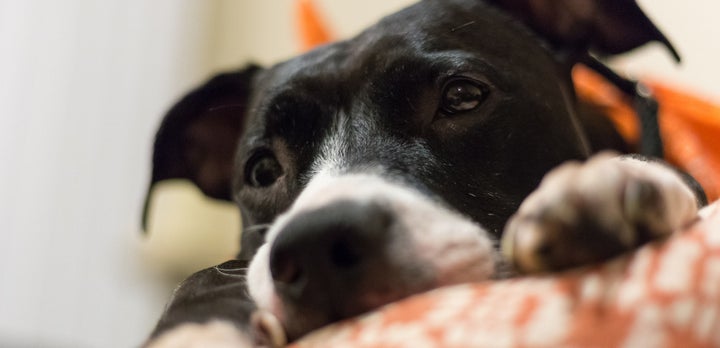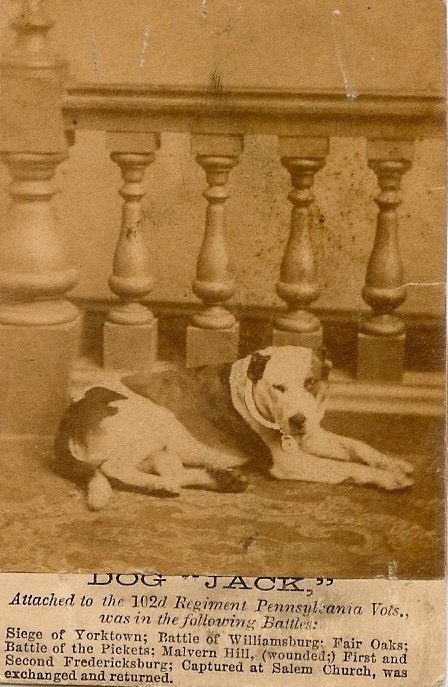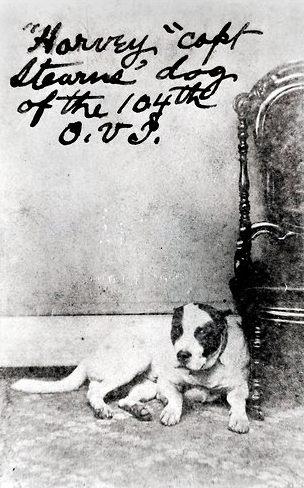
Some of America's most beloved wartime canines wouldn’t even be allowed to live on many military bases today.
The U.S. Army, Marines, Air Force and Air Force Space Command -- as well as some individual Navy bases -- all have polices prohibiting "aggressive" dog breeds from residing in military housing as pets of service members.
The first type of dog named on every single one of these lists? Pit bulls. The policies define "pit bull" differently, since it is not a specific breed, but, rather, a general category. While the Army, for instance, defines pit bulls as "American Staffordshire Bull Terriers or English Staffordshire Bull Terriers," the Marines' policy doesn't define the term at all.
It's unclear how exactly officials determine the breed or type of dog. The Marines policy states that if a dog does not have formal breed certification, a veterinarian will be tasked with determining the breed, and a 2013 article by Amy Bushatz, editor-in-chief of Military.com's family blog, indicates this is the case in the Army as well. Bushatz explains that these classifications, based primarily on looks and first impressions, can be highly arbitrary.
Regardless, the restrictions are somewhat ironic, because not only do pit bulls regularly act as service dogs for veterans, some of the most celebrated canines in U.S. military history were pit bulls as well.
Here are a few historical military pups who would most likely be banned from many military housing facilities today. While not all of their breeds are known, they have all been considered pit bulls at some point by historians and the media based on their appearances, and would likely be classified as such today.
Sergeant Stubby: Decorated Dog

Sgt. Stubby's skin was preserved and stretched over a plaster cast, and is displayed at the Smithsonian's National Museum of American History.
This courageous canine World War I veteran was described as a “bull terrier” in his New York Times obituary and a "pit bull" in historian Michael Lemish's book War Dogs. Stubby was adopted as a pup in 1917 by Pvt. J. Robert Conroy, who found the young dog on the fields of Yale University.
He soon became the mascot of the 102nd Infantry, 26th Yankee Division, and even learned a special dog salute, in which he held his right paw up near his eye. Conroy smuggled Stubby along with him when the unit headed to France, and the commanding officer allowed Stubby to stay after the dog saluted him.
Stubby was reportedly was able to detect poison gas, waking up soldiers in the trenches to warn them to flee, the obituary notes. At one point, he even held a German soldier by his pants until U.S. forces could nab him. The National Museum of American History says Stubby was promoted to the rank of Sergeant after assisting in the capture, though Lemish says Stubby was never officially given rank by the military.
After the war ended, Stubby became a bone-a fide celebrity, touring the country and meeting three different presidents.
One of Stubby’s best traits, though, was his good-natured spirit. From his obituary:
The noise and strain that shattered the nerves of many of his comrades did not impair Stubby's spirits. Not because he was unconscious of danger. His angry howl while a battle raged and his mad canter from one part of the lines to another indicated realization. But he seemed to know that the greatest service he could render was comfort and cheerfulness.
While Stubby wasn't technically awarded any military medals, the men of the 102nd attached a Victory Medal to his collar to commemorate his service, according to Lemish. A group of French women also made Stubby a special blanket after the town of Chateau-Thierry was recaptured by French and American forces. After the war, people who met the "hero dog" would pin medals to the blanket.
He died peacefully in his sleep. Stubby’s skin was preserved on a plaster cast and is now on display at the American History Museum, along with his blanket and medals.
Dog Jack: Canine Prisoner of War

A newspaper clipping featuring Dog Jack.
During the Civil War, the soldiers of the Union’s 102nd Pennsylvania Volunteer Regiment cared so much about Dog Jack -- a mixed-breed dog with a distinctive patch over one eye -- that they exchanged a prisoner of war to get him back after he was captured by Confederate troops in 1863.
Unfortunately, Dog Jack went missing the following year, and no one is sure what happened to him. Some speculate that thieves picked him up because of his silver collar. Soldiers in his regiment later commissioned a portrait of the beloved canine.
The 2010 movie "Dog Jack" was loosely inspired by the dog's life and starred a deaf female pit bull, Piglet, as Jack.
Sallie: Loyal Mascot
This Staffordshire terrier was so beloved by the Union Army’s 11th Pennsylvania Volunteer Infantry during the Civil War that she was commemorated in a monument at Gettysburg. As a puppy, Sallie was given to the regiment as a gift and quickly became its mascot. Sallie demonstrated her incredible loyalty during the Battle of Gettysburg, when she got separated from the troops and was found three days later guarding the bodies of dead soldiers from her unit.
Sallie ultimately lost her life when she was shot in the head during the Battle of Hatcher’s Run in 1865. Her fellow soldiers buried her on the field.
Harvey: Friend To Soldiers And Squirrels

Harvey was one of the most beloved canines in a unit that had so many dogs, it was nicknamed the "barking dog regiment."
Another Civil War pup, Harvey was one mascot of the 10th Ohio Volunteer Infantry, which became known as the “barking dog regiment” because it had so many canines in tow. Harvey’s proud owner inscribed his dog tags with the words “I am Lieutenant D.M. Stearns dog; whose dog are you?”
In a letter home to his children, Capt. William Jordan wrote that Harvey and two other dogs had “the run of the regiment,” and described Harvey saving the life of a squirrel. Another regiment dog, Teaser, chased after the squirrel -- which soldiers were keeping as a pet -- but Harvey picked up the small animal in his mouth and carried it to safety.
The dog was also known for swaying from side to side while soldiers sang campfire songs. Some attributed this to a love of music, though at least one private believed that the music just hurt the dog’s ears.
Harvey was wounded in battle twice, but survived the war, and the soldiers of his unit later memorialized the dog in a portrait and on keepsake buttons.
Contact the author at Hilary.Hanson@huffingtonpost.com.
For the second year, The Huffington Post is holding a week-long, community-driven effort to bust the myths and raise awareness about pit bulls, a maligned "breed" that often bears the brunt of dated, discriminatory legislation that can make it near-impossible for these dogs to find a forever home. You can follow along with HuffPost Pit Bull Week here, or on social media where we'll be using the hashtag #PitBullWeek.
